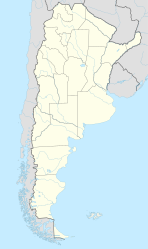San Miguel de Tucumán
|
San Miguel de Tucumán Tucumán |
||
|---|---|---|

(From top to bottom; from left to right) Aerial view of the city; Nacional University of Tucumán; Independence House; Tucumán Government House and the Tucumán Cathedral.
|
||
|
||
| Coordinates: 26°49′59.00″S 65°13′00″W / 26.8330556°S 65.21667°W | ||
| Country |
|
|
| Province |
|
|
| Department | Capital | |
| Established | 1565, 1685 | |
| Government | ||
| • Intendant | Germán Alfaro (ApB) | |
| Area | ||
| • City | 90 km2 (34.88 sq mi) | |
| • Metro | 480 km2 (209.3 sq mi) | |
| Elevation | 431 m (1,300 ft) | |
| Population (2009 est.) | ||
| • City | 527,607 | |
| • Metro | 830,000 | |
| Time zone | ART (UTC−3) | |
| Climate | Cwa | |
| Website | http://www.tucuman.gov.ar/ | |
San Miguel de Tucumán (usually called simply Tucumán) is the capital of the Tucumán Province, located in northern Argentina 1,311 kilometres (815 mi) from Buenos Aires. It is the fifth-largest city of Argentina after Buenos Aires, Córdoba, Rosario and Mendoza and the most important of the northern region. The Spanish Conquistador Diego de Villarroel founded the city in 1565 in the course of an expedition from present-day Peru. Tucumán moved to its present site in 1685.
The city is bordered on the north by Las Talitas (Tafí Viejo), on the east by Banda del Río Salí and Alderetes (Cruz Alta), on the west by the city of Yerba Buena, and on the south by Lules.
The city is located on the slopes of the Aconquija mountains, the easternmost mountain range before the large Chaco-Pampean flats. It is the commercial center of an irrigated area that produces large quantities of sugarcane, rice, tobacco, and fruit, giving the province its nickname, the Garden of the Republic. The National University of Tucumán (1914) and the Saint Thomas Aquinas University of the North (1965) are in the city.
On July 9, 1816, a congress gathered in Tucumán declared independence from Spain, which did not officially recognize it until 1862. The meeting place of the congress, the House of Tucumán, has been reconstructed as a national monument. After the national government broke down in 1820, the town was capital of the short-lived Republic of Tucumán.
...
Wikipedia


